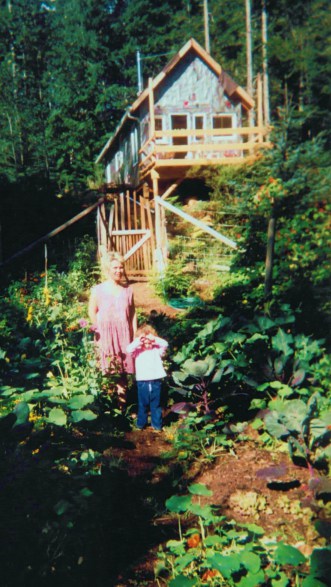12 things you might like to know before heading off the grid
 Friday, January 28, 2011 at 9:15AM
Friday, January 28, 2011 at 9:15AM Michelle Buchanan (@michisle) read Jordon's Small Living post and sent us the story of her family's experience with off-grid living. Originally posted at Michelle's blog, michellebuchanan.ca:
In 1994 my partner and I, fed up with the way society was going, headed to the woods with our little boy. We’d hoped to collect a group of folks to buy land with, but in the end it was just ourselves. We bought ten acres of raw land in a remote bay on Quadra Island and a converted school bus. We insured my old van and headed out.
We spent two months in the bus, parked in a little clearing that the previous owner had made, sketching out cabin plans and buying materials. The van was our tool shed. In September, the rain and hail came and we retreated to a hotel room at the south end of the island. Four months later we moved in to the bones of our small, cold, unfinished cabin. We were in heaven despite having to carry water daily, as we had no plumbing. We had no insulation in our floor and were burning wet wood. We bathed in a tub outside, used a makeshift outhouse, and washed our clothes in town. But the lack of comfort and convenience didn’t seem to matter so much to us then.
Eventually, we built a pump house, an outhouse, a chicken coup, a shed, and dug and fenced a garden. We upgraded the cabin and added to it and over the years built a house, a goat barn, an electrical shed, a wood shed, dug and fenced more gardens, and cleared more land. We did this alongside our other projects, work, homeschooling our son, gardening, foraging some, milking goats, tending chickens, making cheese and yogurt, and preserving the rest of the bounty. Between the hard work there was a lot of play, at the many beaches, along the trails, around campfires, and wood-stoves.
I miss many aspects of that lifestyle, but, some things, I don’t. I don’t miss the tremendous amount of driving I did, getting supplies, and getting my son to and from activities. I don’t miss the type of work that has to be done, right now, and only now, like feeding animals, preserving food while it’s fresh, and keeping the wood-stove going. I don’t miss the power outages, and the ferry line-ups. All in all, however, I chalk it up as having been an amazing experience.
Yet now we’re back in civilization, well, more so than we were, I find that it startles me to hear others pining for retreat, and their earnest rally to grow, hunt, and forage for our own food, to raise chickens, and to compost, while also debating the virtues of various types of animal husbandry. In all seriousness, I wish such folks well in their ventures, my heart is with you (though my back may no longer be). I know that you carry the light of human survival in these dark, and likely to become even darker, times of global warming. That said, here are some things you might want to know before you run for the woods. I’ve listed twelve things, one for every year I lived remotely.
Raw land doesn’t come with a driveway. Sometimes it doesn’t even come with a road. And if it is water access only, it may not come with a dock. Consider this when choosing your location. You will need to bring things in with you, food stuffs, tools, building supplies. Will you be carrying it in on your back? If you barge it in, how will you get it to shore? Wheel-barrows are very useful items in this in this regard. You can hire an excavator to build you a driveway, keep in mind you’ll need a lot of gravel.
Water doesn’t come out of a tap. I know you know this, but do you really? Until you install some sort of water system, you will be packing buckets of the stuff daily. You can dig a shallow well, but, like the creek water you’ll want to boil it so you don’t get beaver fever (and yes, that requires fuel). You can get a deep well dug, that’s the cleanest, most reliable option, as the other two can dry up in warm weather. A deep well will set you back a thousands of dollars. You’ll then need a pump and pump house to get it out of the ground. Yeah, you’ll need electricity for that. Of course, there’s no guarantee that there will be water where you’ve dug. Then there’s the whole septic issue, but you don’t want to hear about that, really, you don’t. The cost is about $10,000 for a septic field. Yes, outhouses are fine. They’re cold in the winter though, and you need to move them every so often, a very yucky job. Composting toilet? I’ve never known one to work as they’re supposed to.
To eat game or your own livestock, you have to kill it. Unless you’ve been raised by indigenous hunters, you will probably need a rifle if you want to hunt, and have some practice using it. A sharp knife is a good thing to have too, should you have to slit the animal’s throat, and of course to clean it and cut it up. A butcher knife works well for cutting chicken’s heads off. Know this too, that goats are difficult to slaughter. They really put up a fight.
Solar power will provide just enough energy for lights, electricity runs along power poles, and hand saws suck. Power poles cost thousands of dollars each to install on your own property, and you need to have power poles to the lot to get power. Oh, but you’re going off-grid, right. So that means you’ll need a gas-powered generator. No? Solar? Okay. Count on using considerably less power than you do right now. Be prepared to monkey wrench daily, put out a great deal of moola for the panels, batteries, and controller, and go to bed early when it’s dark (to conserve what will be your highly valued power). Muscle power you say? See you in 20 years when your doll house is done.
Cell phones don’t work everywhere and there is no internet unless you build it yourself. You might be looking forward to becoming unplugged. You might be looking forward to getting away from it all. Now. And while we’re on the topic of now, you might want to research how to install a wireless system, because you won’t be able to look it up later…without any internet. In terms of choosing your location, you’ll need line-of-sight to someone who has an internet connection. Yes, you can get satellite, but it’s pricey, and not so great if you’re connecting to a Virtual Private Network.
There is no one to take your garbage away but you. That’s right. Live with it in your landscape or take it away yourself, those are your options. You’ll need a secure place to store that garbage too while it’s piling up to take to the dump…then there’s the recycling, you’ll need a place to store that as well between trips to the depot. And don’t be thinking that you’ll just throw you’re old bread and bones and egg shells into the compost now you’re out in the bush. You don’t want to be feeding the bears and wolves now, do you? They’re not the best neighbours.
Shelters, even wood sheds, take a long time to build. Much longer than you’d think, especially when you’re building them yourself and you’re not terribly experienced. Of course you’ll need a shelter pretty quick, but don’t count on being able to build your cabin in a summer while you live in a tent. It will take longer than that, it just will. And don’t forget that all your tools, building supplies, and firewood all need sheltering too.
Modern chickens don’t reproduce, and to get goat milk you need a buck to freshen your doe. Go figure about the chickens, I know. It’s crazy. But it’s true. You can get these little chickens called Banties that are closer to natural stock and will go broody, which means they’ll sit on eggs until they hatch, unlike the commercial kind. Their eggs are really small though, so, ideally, you’ll want both. Chickens also need a lot of protection from predators (more building). Goats, the global animal of self-sufficiency, need to be protected too. They also need to be freshened every couple of years (go ahead, look it up), but you really don’t want to have a buck around that long eating grain and being a stinky pain in the ass. God I hate male goats. Never turn your back on one. And you don’t want to be inbreeding them either. So the freshening issue can be tricky if there aren’t a lot of goats around.
Livestock needs grain to live. It’s how they get their protein. So get planting if you want to live off grid. You’ll need a few acres, yeah, of cleared, fenced land.
It takes a great deal of firewood to heat a home. And like I said before, hand saws suck. You will need to use a chainsaw as you will be cutting truck loads of firewood every year. You will need fuel and oil for your chainsaw. You will need to know how to sharpen and maintain your chainsaw. Oh, and making sure you know how to use your chainsaw safely is a good idea too, as you’ll want to reserve the brain splitting for zombies (that is why you’re out there isn’t it, because you know they’re coming).
Forest floors do not a friendly garden make, and not everything you plant grows. You’ll need a pick-axe if you’re going to cut into the land by hand even after getting a machine to pull out stumps. You can blast the stumps out yourself, but you know, write a will first. It’s arduous, slow work. Count on a small garden to begin with. Of course, you’ll need to fence the garden too, to protect it from the deer. It should be six to eight feet high, depending on the size of the deer in your hood. My advice about gardening in these parts is don’t fight nature too much, grow what grows in your micro-climate, and plenty of it. You’ll learn to love kale, I mean, really love it. You will. Oh, and prepare for slugs. Armies of them will descend upon your tended plot.
It’s nice to have friends. Yes, for all the obvious reasons, and more. Off the grid, you will need each other in many ways, to share work, tools and supplies (there are no corner stores or hardware stores in the bush), to share information with, to have fun, to look after each others children and elderly, to look out for each other if you’re injured or sick, and most importantly, to keep each other from going crazy (though you’ll likely drive each other crazy too, much of the time, being isolated out there, together).






















